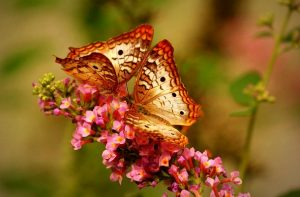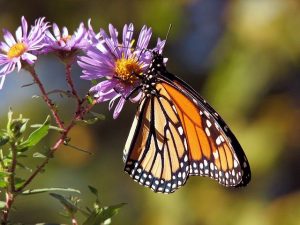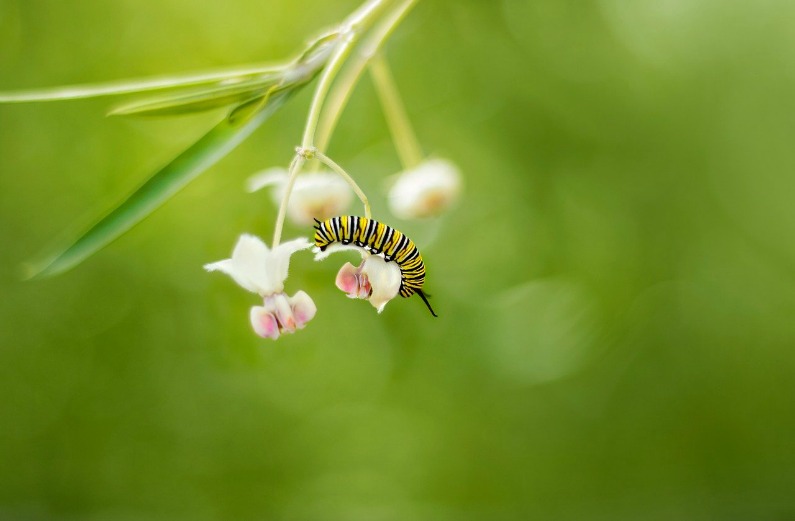“Tell me, sir, what is a butterfly?”
“It’s what you are meant to become. It flies with beautiful wings and joins the earth to heaven. It drinks only nectar from the flowers and carries the seeds of love from one flower to another. Without butterflies, the world would soon have few flowers.”
“It can’t be true!” gasped Yellow. “How can I believe there’s a butterfly inside you or me when all I see is a fuzzy worm?”
“How does one become a butterfly?” she asked pensively.
“You must want to fly so much that you are willing to give up being a caterpillar.”
“You mean to die?” . . .
“Yes and no,” he answered. “What looks like you will die but what’s really you will still live. Life is changed, not taken away. Isn’t that different from those who die without ever becoming butterflies?”
“And if I decide to become a butterfly…” said Yellow hesitantly. “What do I do?”
“Watch me. I’m making a cocoon. It looks like I’m hiding, I know, but a cocoon is no escape. It’s an in-between house where the change takes place. It’s a big step since you can never return to caterpillar life. During the change, it will seem to you or to anyone who might peek that nothing is happening, but the butterfly is already becoming. It just takes time!”
. . . Yellow decided to risk for a butterfly. For courage, she hung right beside the other cocoon and began to spin her own.
“Imagine, I didn’t even know I could do this. That’s some encouragement that I’m on the right track. If I have inside me the stuff to make cocoons — maybe the stuff of butterflies is there too.”
(Trina Paulus. Hope For the Flowers. Paulist Press, 1973.)
 One day I was pondering this little story and I wanted to understand more about how a caterpillar transforms into a butterfly.
One day I was pondering this little story and I wanted to understand more about how a caterpillar transforms into a butterfly.
As ScientificAmerican.com explains:
The caterpillar, or what is more scientifically termed a larva, stuffs itself with leaves, growing plumper and longer through a series of molts in which it sheds its skin. One day, the caterpillar stops eating, hangs upside down from a twig or leaf, and spins itself a silky cocoon or molts into a shiny chrysalis. Within its protective casing, the caterpillar radically transforms its body and eventually emerges as a butterfly or moth.
But what does that radical transformation entail? How does a caterpillar rearrange itself into a butterfly? What happens inside a chrysalis or cocoon?
First, the caterpillar digests itself, releasing enzymes to dissolve all of its tissues. If you were to cut open a cocoon or chrysalis at just the right time, caterpillar soup would ooze out. But the contents of the pupa are not entirely an amorphous mess. Certain highly organized groups of cells known as “imaginal discs” survive the digestive process. Before hatching, when a caterpillar is still developing inside its egg, it grows an imaginal disc for each of the adult body parts it will need as a mature butterfly or moth — discs for its eyes, for its wings, its legs and so on.
Once a caterpillar has disintegrated all of its tissues except for the imaginal discs, those imaginal discs use the protein-rich soup all around them to fuel the rapid cell division required to form the wings, antennae, legs, eyes, genitals and all the other features of an adult butterfly or moth.
 As I read about what happens inside a cocoon, I was fascinated and I quickly started seeing the symbolism of our mortal life. We experience a similar transformation as we invite the Atonement to work in our lives. I used to think the Atonement only applied to us at the judgment seat when we stand before Heavenly Father and Jesus to be judged — yet as I’ve seen the gospel work in my life as well as in the lives of others around me, I understand the Atonement is the healing, strengthening, transformational power that changes us from the natural man/woman into the amazing person we were created to be. We came into mortality with the “imaginal discs” of who we really are as God created us. Part of that process is growing to the point to where we “want to fly so much that we are willing to give up being a caterpillar” — to want to be reunited with our Heavenly Parents so much that we are willing to give up being the natural man. We want to align our will to the Father’s will.
As I read about what happens inside a cocoon, I was fascinated and I quickly started seeing the symbolism of our mortal life. We experience a similar transformation as we invite the Atonement to work in our lives. I used to think the Atonement only applied to us at the judgment seat when we stand before Heavenly Father and Jesus to be judged — yet as I’ve seen the gospel work in my life as well as in the lives of others around me, I understand the Atonement is the healing, strengthening, transformational power that changes us from the natural man/woman into the amazing person we were created to be. We came into mortality with the “imaginal discs” of who we really are as God created us. Part of that process is growing to the point to where we “want to fly so much that we are willing to give up being a caterpillar” — to want to be reunited with our Heavenly Parents so much that we are willing to give up being the natural man. We want to align our will to the Father’s will.
I am reminded of something I read in a talk, “Lord, I Love Thy Holy Habitation.”
“The baptistry is the first ordinance room we can experience in the temple. We often speak of baptism as a cleansing process, but perhaps this is wishful thinking on our part. Baptism is not about cleansing so much as it is about dying, for coming to know God will require a change so radical as to be like a death. In this room we submit to the water as we would submit to a grave, a place that returns things to native element, dissolving and breaking things apart until it is all matter unorganized. This is not what we have in mind when we come to Christ for healing. When we have reached the limits of how far our old assumptions will take us, we would quite prefer that God simply make our lives work again and put them back the way they were. That failing, we hope that maybe He can change other people, or that He will change the rules of life itself. What does not occur to us is that He will ask us to change, and to change the very assumptions which we thought made us safe. Yet baptismal waters testify that old ways of understanding who we are, old ways of trying to be safe and in control, old ways of trying to get our needs met. These coping mechanisms must often die and dissolve before we can be reborn as children of Power.
In the temple baptistry, the only temple room in which all the work done is for the dead, we also remember that we are products of an ancestral heritage that may include both access to spiritual blessings, and the blinding, wounding legacy of unrighteous traditions of fathers and mothers. In fact, these traditions are part of what we may have to let go of so that we can claim our birthright in the family of God. So, the baptistry does more than offer new birth to the dead; it also calls us, the living, to engage in the two mortal acts of single greatest worth to our soul: to repent and to forgive. As we repent of the sinful ways we have learned through our experience with our culture and with prior generations, I believe we help release our ancestors and others who have helped shape the culture we live in from spiritual prisons of regret and remorse which they must experience as they see their sins perpetuated in our lives. As we truly forgive them, we may also be ready to forgive ourselves.
When I go looking for God in the baptistry I ask myself, “What needs to die in my life right now so that I can more fully claim my birthright within my heavenly home? To what new freedoms is God calling me? Is it time to give up on the shame that is simply another form of pride? Does my insistence on being in control need to be laid to a permanent rest? Is it time to catapult fear of failure, of loneliness, or of death — fears that enslave my life in unholy ways?” The baptistry reminds us that Jesus knows all about dying, and that we can afford to trust that the hand that pulls us down into the watery grave will also raise us again.”
(“Lord, I Have Loved the Habitation of Thy House…,” Wendy Ulrich, Ph.D.)

To read more of Sonja’s articles, click here.
Processing the experiences we’ve been through is what adds to our wisdom and it’s why it is so important to repent, forgive ourselves, let go of any traces of guilt, shame, blame and judgment about the path we had to travel in order to learn from the things we experience. It was not intended that we would only use the past as a way to denigrate ourselves.
Looking back at my life lessons, I understand that for those who resist lessons, there are additional lessons. I’ve taken tests I’ve failed and been grateful for the tests I got to take over once I learned more. All the while, those “imaginal discs” born inside each of us are responding to the gift of the Atonement. Heavenly Father didn’t leave anything out of the plan of happiness.
The Atonement is intended to help us through this laboratory of learning. It was never intended to be reserved for judgment day. President Nelson has said, “[I]n coming days, it will not be possible to survive spiritually without the guiding, directing, comforting, and constant influence of the Holy Ghost.” Becoming the person we were created to be is a process that continues long after we leave mortality. It takes time, experience, endurance, patience, healing, and letting go of the person we were. As Yellow found out, “What looks like you will die but what is really you will still live. Life is changed, not taken away.”
About Sonja Hopkins
Sonja lives with her husband, Dale, on Anderson Island, Washington. She and her husband are Church Service Missionaries serving in the Addiction Recovery Program, focusing on pornography and sex addiction. She is also a certified life coach and teaches "Life Skills for Emotional Self-Mastery" in her stake twice a month. She does not teach you only to process something traumatic done to you in the past; rather, she helps you learn to feel it, heal it, and LET GO of whatever you still do to yourself and to others in order to cope with what was done to you in the past.
Twitter •







Thank you for this post! It is exactly what I have been needing to hear. I am grateful that you took the time to share these beautiful words.